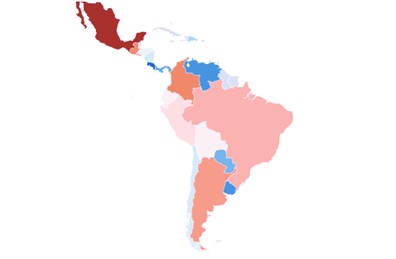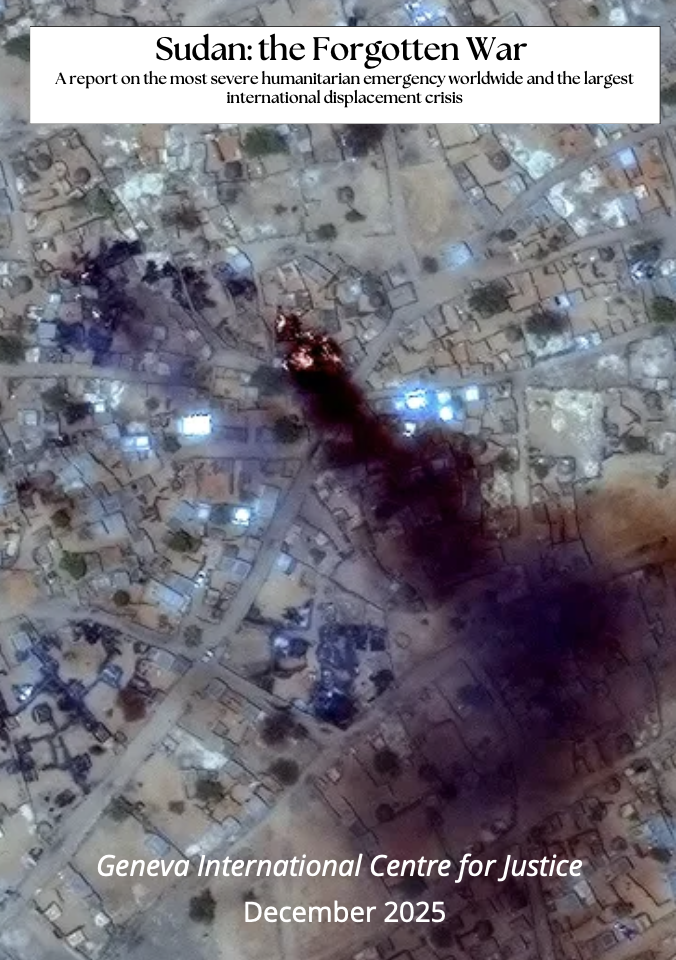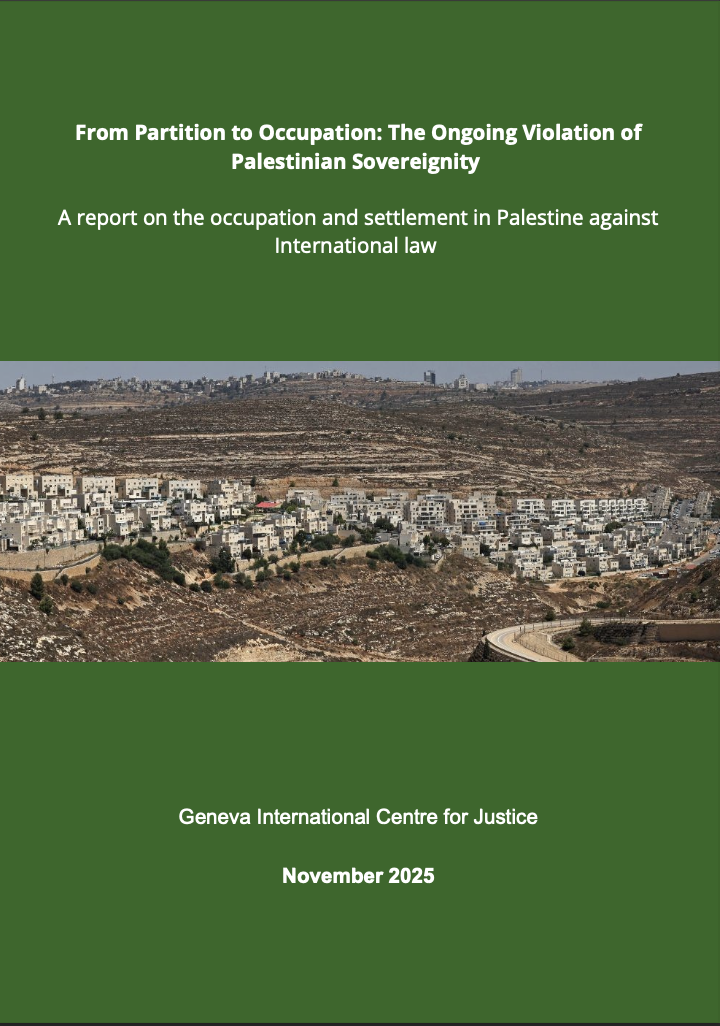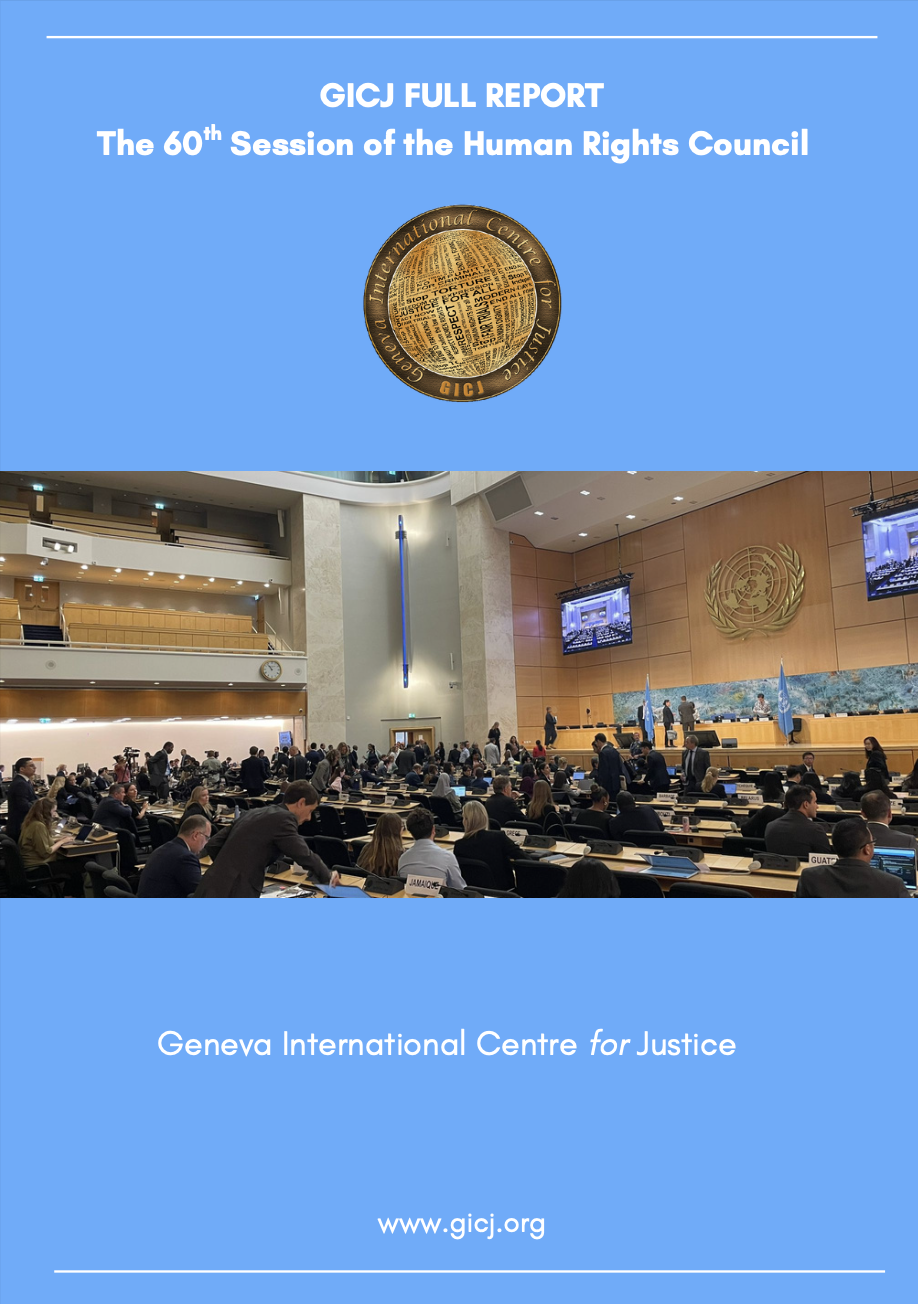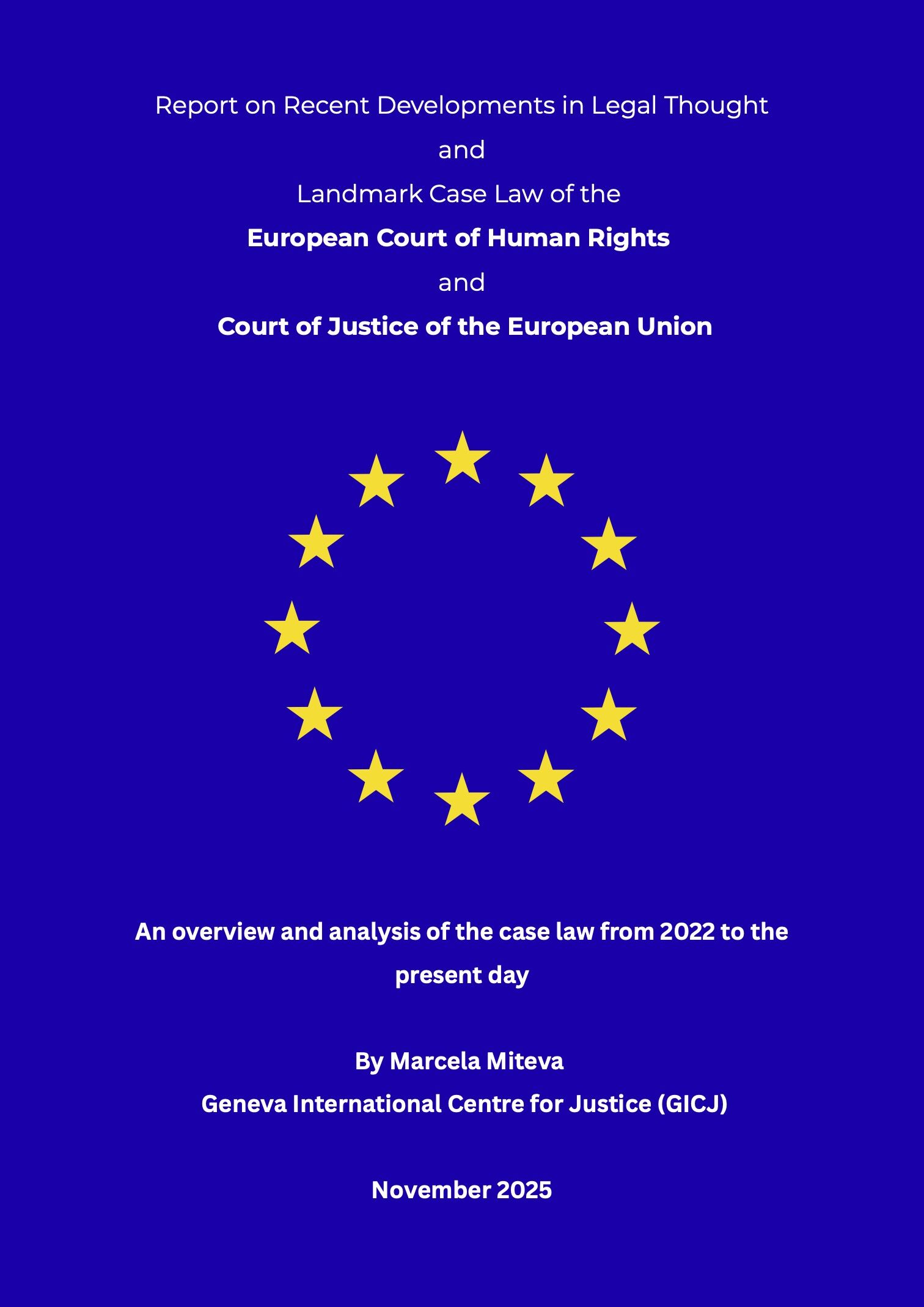22 November 2019
By: Valentina Ferreira Gutiérrez
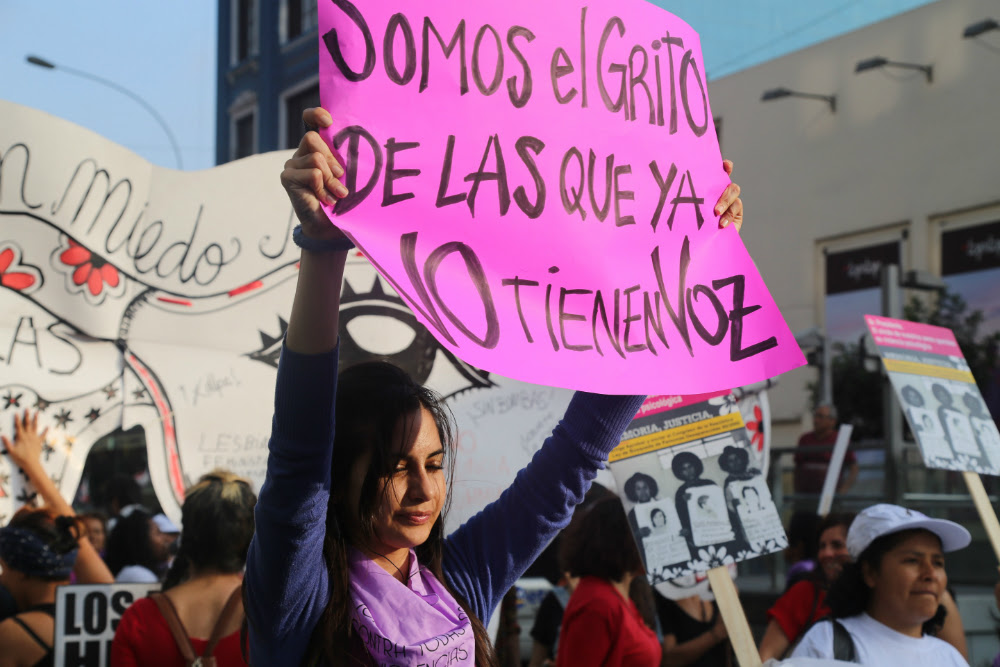
Source: LaMula.Pe
Violence against women and girls (VAWG) is globally widespread. As it is still a sadly common phenomenon, we will continue to commemorate every year 25 November, in memory of all women and girls worldwide who have suffered, continue suffering, or did not survive gender-based violence of any kind.
The event that gave rise to this commemoration dates to 1960 when the Mirabal sisters were brutally assassinated by the secret police of the dictator of the Dominican Republic, Rafael Leónidas Trujillo (1930-1961). Patria, María Teresa, and Minerva Mirabal were known for their activism during the dictatorship, and before their assassination they received threats to which Minerva replied: “If they kill me, I'll take my arms out of the grave and be stronger”[i]. That is exactly what happened, as this crime was the beginning of the end for Trujillo’s regime: six months later, the Dominican dictator was assassinated and 79 years later we are still commemorating 25 November in their honour and the one of every women and girls around the world.
Therefore, since 1981, 25 November is a symbolic day in Latin America for the elimination of violence against women. For the rest of the world, we must wait until 1999, when the United Nations General Assembly declared 25 November as the International Day for the Elimination of Violence against Women. This was six years after the adoption by the General Assembly of the Declaration on the Elimination of Violence against Women by resolution 48/104 on 20 December 1993.
But, what do we really mean by “violence against women”? The UN Declaration defines it as:
“…[A]ny act of gender-based violence that results in, or is likely to result in, physical, sexual or psychological harm or suffering to women, including threats of such acts, coercion or arbitrary deprivation of liberty, whether occurring in public or in private life.”[ii]
For this purpose, violence against women or girls encompasses any form of physical, sexual, and psychological violence perpetrated either within the family, the wider community, or derived from State violence. It includes all forms of rape against women, female children, marital rape, battering, dowry-related, female genital mutilation, sexual exploitation, sexual harassment, and intimidation at work or in educational institutions, among others[iii].
For all these reasons, the UN General Assembly invites in this day, all the States, international organisations, and NGOs, to rally to the cause and raise public awareness on this critical issue women and girls are suffering from.
Violence against Women: explained
Among all the types of gender-based violence we previously mentioned, some of them are worth to be explained, as it allows women who have suffered from any kind of violence to put a name on it.
One of the most common types of violence against women, is the one perpetrated by an intimate partner. It can be an actual or former partner or husband, who, by his behaviour, causes physical, sexual or psychological harm[iv]. What is shocking about that kind of violence, is that most of the world’s countries have outlawed it[v], either physical domestic violence, or marital rape to give some examples. This therefore represents an obstacle towards justice for the victim, preventing her partner from being legally held accountable.
A second type of violence, which is most talked about, is sexual violence, namely rape or sexual harassment. Sexual violence and/or harassment can occur in various circumstances. It can either occur through unwelcomed sexual advances in public spaces, children abuse and forced marriage.
Women are also a major target of human trafficking representing over 70% of the victims[vi]. Human trafficking is the forced acquisition and exploitation of a person for illegal activities such as drug trafficking, sexual slavery or forced labour for instance. Female victims of such crimes are mostly used for sexual exploitation.
Female genital mutilation (FGM) is still nowadays very common in some cultures. This is a procedure where female genital organs are deliberately altered or injured for non-medical reasons. Despite governments’ tentative to punish it, it is very difficult to have control over it. On top of that, the issue of FGM raises concerns as most the victims are under 5 years old[vii].
One last type of violence against women, and more specifically girls, is child marriage. According to UNICEF reports, 650 million of girls alive today were forcibly married before turning 18 years old[viii]. This has serious consequences for the girls as it seriously affects their education, exposes them to sexual abuse and it also violates their right to make their own life choices.
To all these types of violence against women, we must add femicide. This is the most violent type of gender-based violence, simply for being women. It can either be perpetrated by a partner, former partner or an unfamiliar person after a rape, sexual assault, or a break up.
No country is free from violence against women, some regions are more prone to this issue than others. Here, we are going to present a short overview of the situation in Latin America.
Violence against women in Latin America
Latin America is sadly known for being one of the world most dangerous regions for women. Indeed, 14 out of 25 countries with most femicides in the world are in Latin America[ix]. A frightening figure of about twelve women killed every day in all Latin America and the Caribbean, puts the region at the top of the most dangerous places for women. It is important to notice that not all countries have legislated on femicide. Costa Rica led the way by being the first country of the region to do so in 2007, followed by Guatemala in 2008. Nevertheless, most of Latin-American countries waited until the 2010s to do so, Uruguay being the latest in 2017.
|
|
However, these figures hide a large number of femicides that are not investigated as such. That was the case of a Chilean girl aged 17 who was killed by her 18-year-old ex-boyfriend. As they were not married nor did they live together, the legal system did not recognise it as femicide. Such similar cases also happen in other countries of the region and make us fear that the actual rate could be much higher. Other figures show that every year nearly three thousand women are killed in the region, just for being women[x]. Two major cases raise our concerns today, namely Mexico and Chile for which we will provide more details below.
Mexico
Mexico is sadly leading the 2019 ranking with three women killed every day and 49 suffering from sexual abuse. Not only Mexico is now known for its highest rate of femicide in the region, but also for abuse and harassment. During the first half of this year, nearly 11,700 cases of sexual abuse have been recorded, and almost 6,600 cases of rape[xi]. If all the femicides were investigated as such in the country, the rate would rise to more than a thousand of victims for 2019[xii].
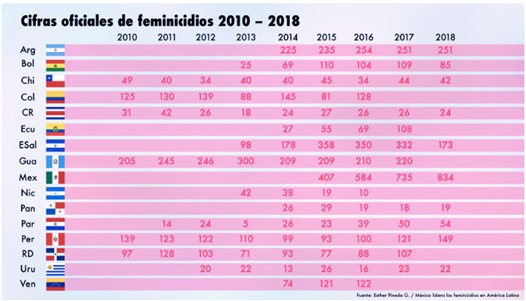
Most of the cases of gender-based violence in the country have been perpetrated by the husband or former partner of the victim. The National Institute of Statistics and Geography estimated, for 2018, that out of 100 women aged 15 and above, who have or had a partner, 42 of the married ones and 59 of the separated, divorced or widowed, have experienced violence of any kind[xiii].
In the table above, we can see that the rates of femicides increases alarmingly every year, making us fear that Mexico will end the current year with the highest rate in the region.
Chile
Although Chile is not considered to be the worse place for women to live in Latin America, the current situation the country is going through has reflected serious women’s rights violation perpetrated by police and military forces.
Since 18 October 2019, Chile is facing the biggest social mobilisation since the return to democracy. People from all backgrounds are in the streets demanding better living conditions and the end of neoliberalism, which was established by the dictatorship of Augusto Pinochet (1973-1990). After over a month of protests, Chile is facing the most violent repression ever seen in democracy, counting more than 6,300 detainees, of whom 951 are women and 759 are children, girls and teenagers[xiv]. Moreover, the Chilean National Human Rights Institute (NHRI) has registered 66 complaints for sexual violence[xv] perpetrated by police or military officers, and is currently representing 117 women victims.
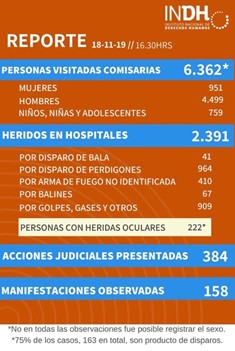 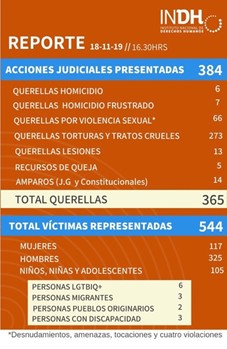 Image 3: National Human Rights Institute, report of 18 November 2019 |
Several cases of women being detained and abused inside police vans were reported and some even accused the police of threatening them with gang rape. Most vulnerable women are those who are pregnant, as Carabineros do not make any difference when repressing the people of Chile. Recently, in the small neighbourhood of Lo Hermida, in Santiago, police forces launched a violent offensive. They broke down the door of a house, broke everything inside, detained all the family including a pregnant young woman whom they kicked right in the face[xvi]. Several cases of abortions and premature births have also been registered, as air is severely polluted with tear gases[xvii].
The most shocking case though, is the one of the street performer Daniela Carrasco, known as La Mimo – The Mime. At the beginning of the protests, she was detained in Santiago by the police and found dead hours later, hanging from a fence in a park with obvious marks of rape and torture. Feminist collective, #NiUnaMenos, is calling for an investigation to be launched, claiming that Daniela was seen for the last time when detained by Carabineros.
The current Minister of Women and Gender Equity, Isabel Plá, has showed very little concern about all the cases of violence against women and pregnant women perpetrated by police forces during the protests. Chileans are now asking for her resignation, as she waited nine days to make a declaration about this issue, when several complaints about sexual violence were already registered and made public by the NHRI[xviii]. This situation is worrying as it manifests a systematic and institutional violence against women in the country.
These specific cases show the level of violence perpetrated against women in the Latin American region. Not only in situation of conflict or social mobilisations, but also in the everyday life, women are subjected to gender-based violence at a domestic and institutional level.
GICJ position
Geneva International Centre for Justice (GICJ) condemns all forms of violence against women and girls, and reminds also that the gender of a person must never be a reason to be abused or assaulted either physically, sexually or psychologically. GICJ would like to emphasise that gender equity and safety of women and girls is part of the Sustainable Development Goals (SDGs) to which all UN member States agreed. GICJ calls, therefore, on international community and all States to increase their efforts to protect the rights and integrity of all women and girls around the world, regardless of their origins, ethnic group, culture, or religion.
[i] BBC (25 November 2017). https://www.bbc.com/mundo/noticias-internacional-42060899
[ii] UN DEVAW art. 1
[iii] UN DEVAW art.2
[iv] UN Women. https://interactive.unwomen.org/multimedia/infographic/violenceagainstwomen/en/index.html#home
[v] Women, Business and the Law 2018
[vi] Global Report on Trafficking in Persons, UNODC, 2016
[vii] Female Genital Mutilation/Cutting: A global concern, UNICEF, 2016
[viii] Child Marriage: Latest Trends and Future Prospects, UNICEF, 2018
[ix] El País (10 August 2019). https://elpais.com/elpais/2019/08/06/planeta_futuro/1565107246_365654.html
[x] Latinoamerica Piensa (8 March 2019). https://latinoamericapiensa.com/8m-cada-ano-son-asesinadas-casi-3000-mujeres-en-america-latina/16113/
[xi] Latin American Post (24 August 2019). https://latinamericanpost.com/29792-these-are-the-numbers-of-feminicides-in-latin-america
[xii] Infobae (30 May 2019). https://www.infobae.com/america/mexico/2019/05/30/feminicidio-en-cifras-rojas-en-mexico-asesinan-diariamente-a-nueve-mujeres/
[xiii] Instituto Nacional de Estadísticas y Geografía. Estadísticas a propósito del Día internacional de la eliminación de la violencia contra la mujer (25 de noviembre) / datos nacionales. P.2 (22 November 2018). https://www.inegi.org.mx/contenidos/saladeprensa/aproposito/2018/violencia2018_Nal.pdf
[xiv] Instituto Nacional de Derechos Humanos. (18 November 2019)
[xv] There are also some cases of rape perpetrated by police officers against men.
[xvi] Telesur (12 November 2019). https://www.dailymotion.com/video/x7nwu6t
[xvii] El Desconcierto (14 November 2019). https://www.eldesconcierto.cl/2019/11/14/abortos-y-partos-prematuros-la-violencia-que-sufren-las-mujeres-embarazadas-por-la-represion-de-las-movilizaciones/
[xviii] El Desconcierto (9 November 2019). https://www.eldesconcierto.cl/2019/11/09/isabel-pla-contra-las-cuerdas-los-argumentos-de-las-organizaciones-feministas-para-exigir-la-renuncia-de-la-ministra-de-la-mujer/
*Intro Image Source: LaMula.Pe
Keywords: Women, 25 November 2019, Violence against Women, CEDAW, Justice, Geneva, Human Rights, Geneva4Justice.
Justice, Human rights, Geneva, geneva4justice, GICJ, Geneva International Centre For Justice




